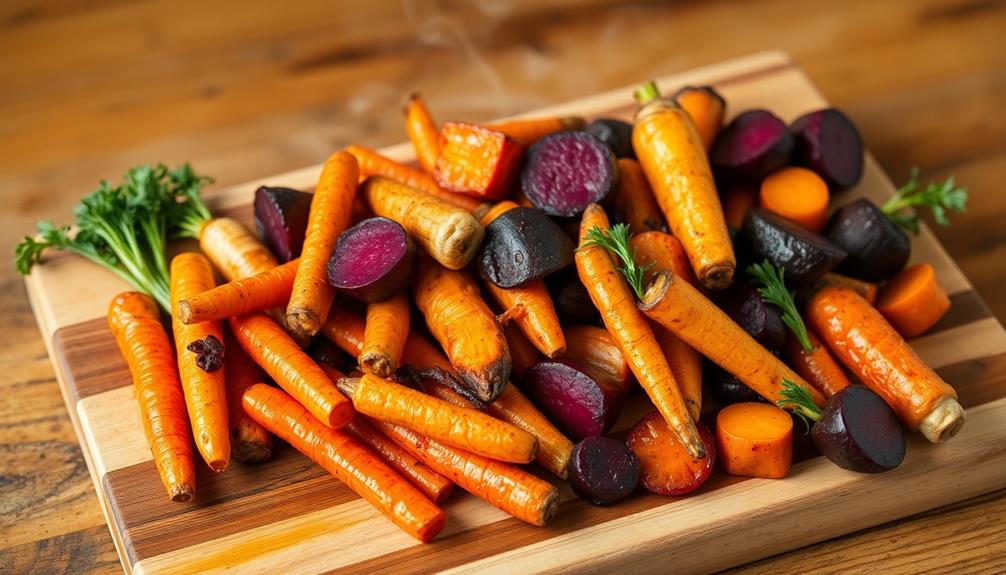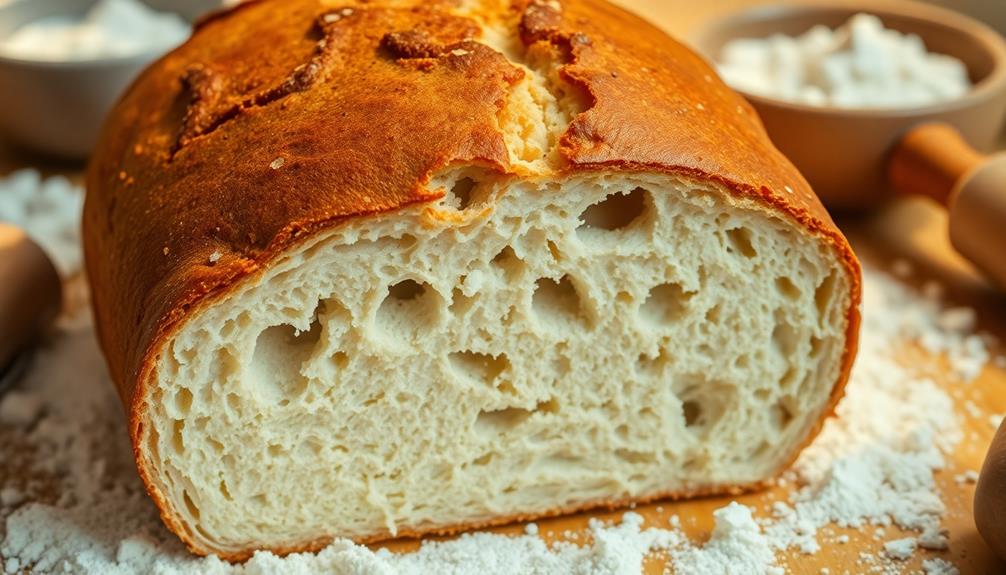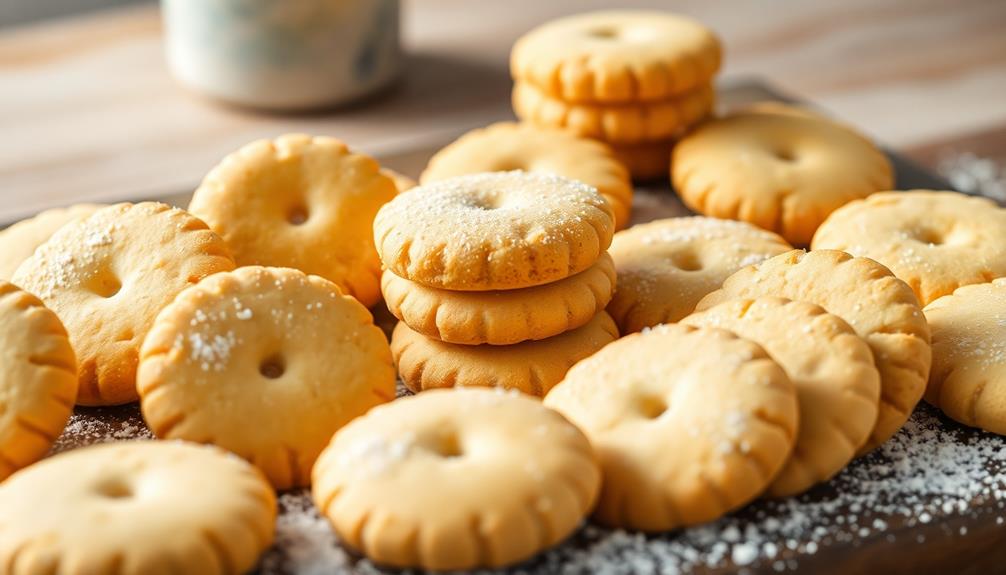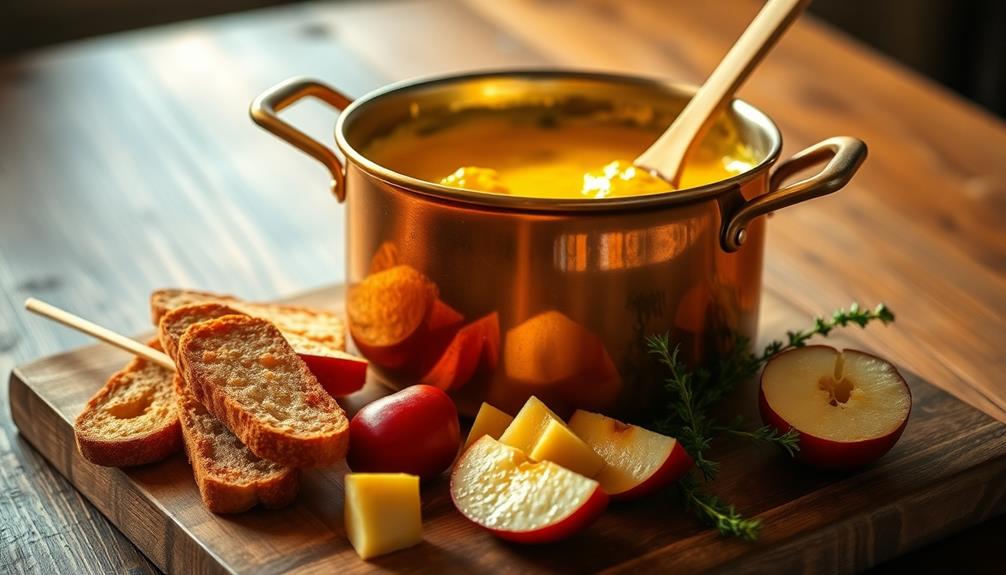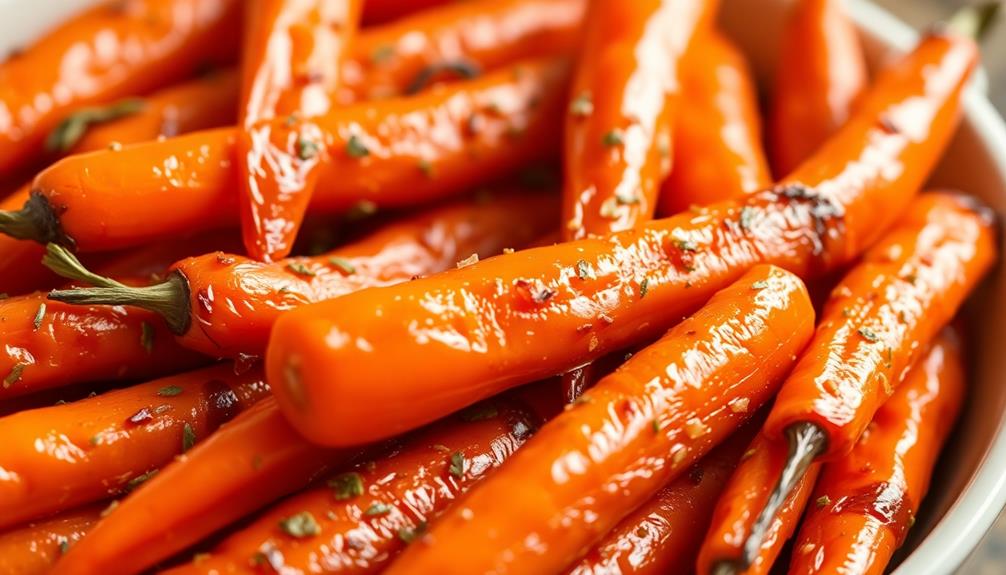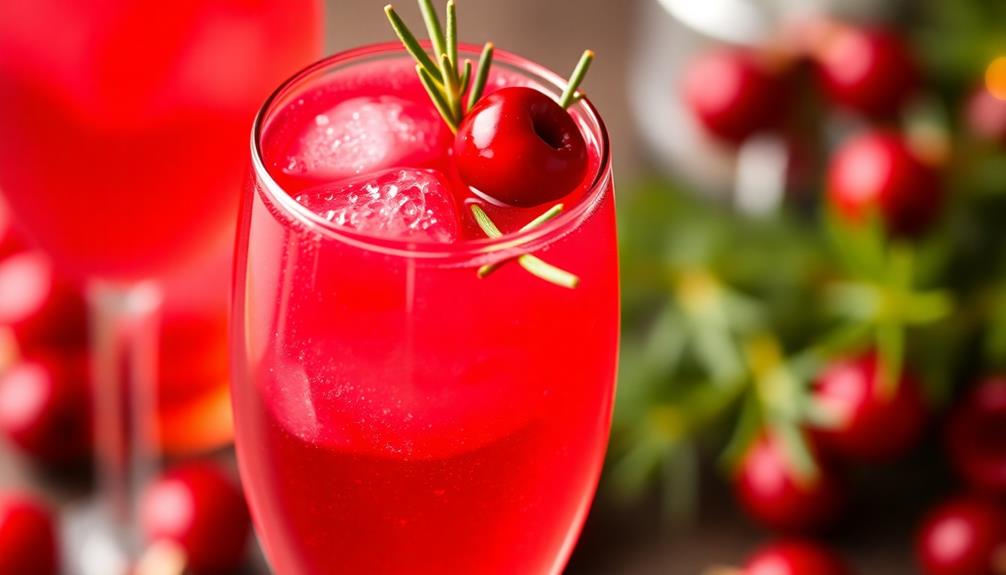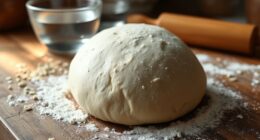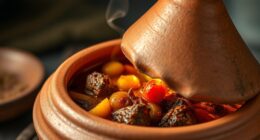Roasted root vegetables are a delight for the senses! These golden beauties, like carrots, potatoes, and parsnips, transform into caramelized perfection when roasted. The natural sweetness intensifies, and the crispy edges add satisfying texture. It's a simple yet stunning side dish that'll have your taste buds dancing. Just toss the veggies in oil, sprinkle with seasonings, and let the oven work its magic. In no time, you'll have a colorful, flavor-packed dish that's sure to impress. Want to know how to take your roasted root veggies to the next level? Keep reading to discover the secrets.
Key Takeaways
- Roasted root vegetables, including carrots, potatoes, and parsnips, have been a popular side dish since the 19th century due to their enhanced natural sweetness and crispy exterior.
- Roasting is a simple yet effective cooking method that brings out the diverse flavors and textures of a variety of root vegetables.
- The recipe is highly customizable, allowing for the incorporation of various seasonings and herbs to suit individual preferences.
- Roasted root vegetables are a versatile and visually appealing dish that can be served as a side or the main feature of a meal.
- Roasting is a healthy cooking technique that retains the nutrients of the vegetables while adding depth of flavor.
History
Although the origins of roasted root vegetables can be traced back to ancient civilizations, the dish gained widespread popularity in the 19th century. Back then, people often roasted a variety of root veggies like carrots, potatoes, and onions to make a hearty, flavorful side dish.
Can't you just imagine the mouthwatering aroma wafting through the kitchen?
Roasting was a simple yet effective way to bring out the natural sweetness and nutty notes of these humble root vegetables. As the oven's heat caramelized the sugars, it created a crispy, golden-brown exterior while keeping the interior tender and creamy. Yum!
This comfort food quickly became a staple on family dinner tables across Europe and North America.
Today, roasted root veggies remain a beloved classic. Whether you're making them for a cozy weeknight meal or a fancy holiday spread, they're sure to please everyone's palate.
Recipe
Roasted root vegetables are a delightful and versatile side dish that can accompany a wide range of main courses. The combination of different root vegetables, such as carrots, potatoes, and parsnips, creates a medley of flavors and textures that are both comforting and nutritious.
Roasting the vegetables brings out their natural sweetness and caramelizes the edges, resulting in a dish that's both visually appealing and full of flavor. This recipe is easy to prepare and can be customized to suit your personal preferences.
- Carrots, peeled and cut into 1-inch pieces
- Potatoes, peeled and cut into 1-inch cubes
- Parsnips, peeled and cut into 1-inch pieces
- Onion, diced
- Garlic cloves, minced
- Olive oil
- Salt and pepper
Preheat your oven to 400°F (200°C). Spread the prepared vegetables on a large baking sheet, drizzle with olive oil, and season with salt and pepper. Toss the vegetables to ensure they're evenly coated.
Roast for 30-40 minutes, stirring occasionally, until the vegetables are tender and caramelized.
When roasting root vegetables, it's important to cut the pieces into similar sizes to ensure even cooking. You can also experiment with different seasonings, such as rosemary, thyme, or paprika, to add extra flavor.
Additionally, consider mixing in other vegetables, such as Brussels sprouts or sweet potatoes, to create a more diverse and colorful dish. For example, you could try a roasted brussels sprouts recipe to add a pop of green to your dish and provide a slightly bitter, nutty flavor. Similarly, adding sweet potatoes can bring a vibrant orange hue and a touch of sweetness. These additions not only enhance the visual appeal of your meal but also provide a wider range of flavors and nutrients. Experimenting with different vegetables can take your dish to a whole new level.
Cooking Steps
First, preheat your oven to a toasty 400°F.
Next, toss those delicious root veggies with a drizzle of oil and your favorite spices.
Then, pop them in the oven and roast until they're tender and irresistible.
Don't forget to give them a gentle toss halfway through for even cooking.
Serve these roasted root veggies piping hot and enjoy every bite!
Step 1. Preheat Oven to 400°F

To begin, preheat your oven to 400°F. This nice, toasty temperature is perfect for getting your veggies nice and crispy on the outside, while keeping them tender and delicious on the inside.
You'll want to make sure your oven is fully heated before popping in those tasty root vegetables.
Once your oven has reached the desired temperature, you can start preparing the rest of your ingredients. Chopping, dicing, and tossing your root veggies in a bit of oil and seasonings will help them develop that irresistible caramelized flavor.
Don't be afraid to get creative with your spices – a dash of garlic powder, a sprinkle of rosemary, or a pinch of cayenne can take your roasted roots to the next level!
With your oven all heated up and your veggies prepped, you're well on your way to enjoying a delicious and healthy roasted root vegetable dish.
Get ready for your kitchen to be filled with the most mouthwatering aroma!
Step 2. Toss Vegetables With Oil and Spices

Next, toss the prepared root vegetables with a few tablespoons of olive oil.
Gently mix the vegetables until they're evenly coated. This will help the spices stick and ensure everything cooks up nice and crispy.
Now, let's add some flavor! Sprinkle on a pinch of salt, pepper, garlic powder, and any other herbs or spices you love.
Maybe a dash of paprika for a pop of color? Rosemary would also be delicious. Get creative and use your favorite seasonings. Toss everything together until the veggies are fully seasoned.
Once your oven is hot and ready, spread the seasoned vegetables out in a single layer on a large baking sheet.
This will help them roast to perfection – no steaming or sogginess here! Roast for 30-40 minutes, flipping halfway, until the veggies are tender and lightly browned.
Your kitchen will smell amazing! Can't wait for you to take a bite.
Step 3. Roast Vegetables Until Tender

The oven should now be preheated to the proper temperature, around 400°F (200°C). Once it's nice and hot, it's time to get those veggies roasting!
Grab your favorite root vegetables – maybe some carrots, potatoes, and parsnips – and cut them into bite-sized pieces. For a delightful twist, you might consider roasting some sweet potatoes or adding a touch of spices to enhance the flavor, much like the Fried Egg Quesadilla Toast that combines savory elements for a delicious breakfast.
Toss them in a large baking dish with a drizzle of olive oil, a sprinkle of salt and pepper, and any other seasonings you'd like. Give everything a good stir to make sure the veggies are evenly coated.
Now, pop the dish in the oven and let the magic happen! As the vegetables roast, they'll start to caramelize and develop a delicious, golden-brown crust. The aroma wafting through your kitchen will make your mouth water.
Keep an eye on them, giving the dish a gentle stir every now and then, until the veggies are tender and easily pierced with a fork, about 25-30 minutes. Once they're perfectly roasted, you're ready to enjoy your flavorful, nutrient-packed side dish!
Step 4. Toss Vegetables Halfway Through
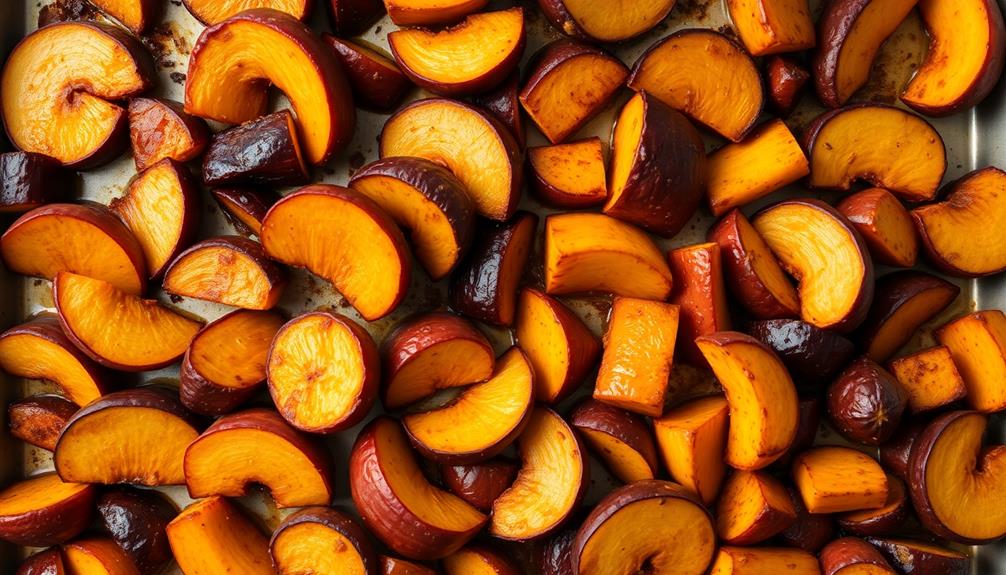
Halfway through the cooking time, be sure to open the oven and give the veggies a good toss. This will help them brown evenly and ensure a delicious, caramelized finish.
Use a pair of tongs or a sturdy spatula to gently lift and flip the chunks of root vegetables. Don't be too rough – you want to keep them in nice, bite-sized pieces.
As you toss, you'll get a whiff of the roasted, earthy aroma, and your mouth will start to water. The tops should be lightly golden, and the insides will be tender and creamy.
Once everything is evenly distributed, pop the pan back in the oven to finish cooking. Keep an eye on them, and give another quick toss if needed.
Soon, you'll have a colorful, flavorful medley of roasted roots to enjoy. The anticipation will be worth the short extra effort!
Step 5. Serve Immediately While Hot
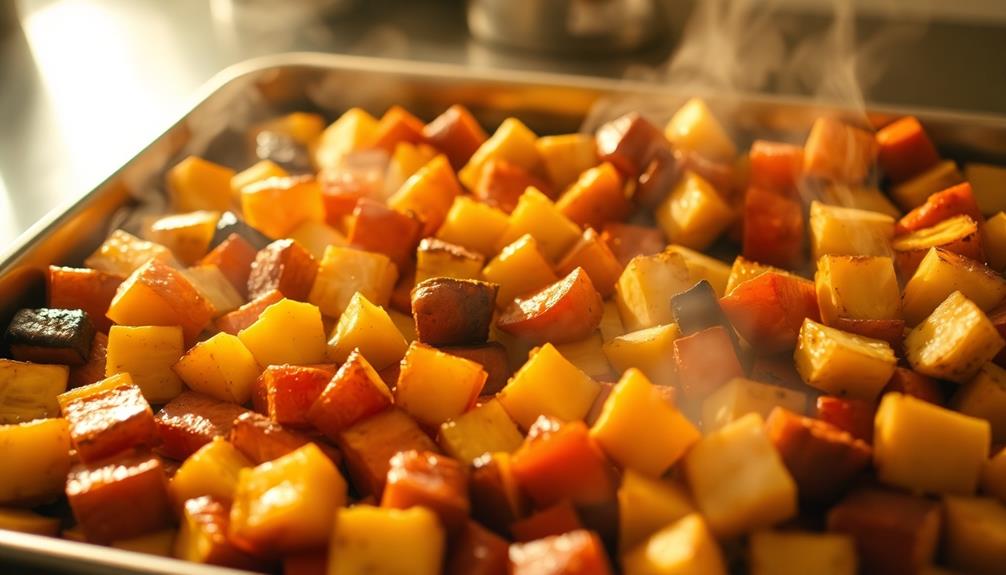
Once the vegetables have reached the perfect caramelized state, it's time to serve them up. Grab your oven mitts, because these roasted beauties are piping hot and ready to enjoy! The enticing aroma of the crispy edges and the soft, tender centers will have your mouth watering.
Carefully transfer the roasted vegetables from the baking sheet to a serving dish. Be sure to scrape up any delicious browned bits left on the pan – those are the best parts!
Arrange the vegetables in a visually appealing way, showcasing their vibrant colors and unique shapes. Now, it's time to dig in!
Serve the roasted root vegetables immediately, while they're still steaming hot. The combination of the earthy, sweet flavors and the contrast of the crispy outside and the creamy inside is simply irresistible.
Encourage your family or guests to pile their plates high and savor every bite. These roasted veggies are the perfect side dish to any meal, sure to satisfy everyone's taste buds.
Final Thoughts
Roasting root vegetables is a simple yet rewarding cooking method that brings out their natural sweetness and depth of flavor. You can easily make this tasty dish for your family and friends, whether it's a weeknight dinner or a special occasion.
The best part? The roasted veggies are endlessly customizable. Try different seasoning blends, herbs, or even a drizzle of honey for a touch of sweetness.
And don't be afraid to get creative with the types of roots you use – carrots, parsnips, beets, and potatoes all make delicious additions.
Once your veggies are tender and caramelized, you'll be amazed at how much flavor they've developed. Serve them as a side dish or even as the star of the meal.
They're sure to be a hit with everyone at the table. So why not give roasted root vegetables a try? Your taste buds will thank you!
Frequently Asked Questions
How Long Do Roasted Root Vegetables Last in the Refrigerator?
Roasted root vegetables typically last 3-5 days in the refrigerator when stored properly. To maximize freshness, you'll want to keep them in an airtight container and consume them within that timeframe for the best quality and flavor.
Can I Use Different Types of Root Vegetables in the Recipe?
Yes, you can use a variety of root vegetables in the recipe. Feel free to mix and match different types like carrots, potatoes, parsnips, and beets to create a flavorful and colorful dish.
What Is the Best Way to Reheat Leftover Roasted Root Vegetables?
To reheat your leftover roasted root veggies, preheat the oven to 400°F. Spread them out on a baking sheet and warm them up for 10-15 minutes, tossing halfway through. This will help them crisp up again without drying them out.
Can I Prepare the Vegetables Ahead of Time Before Roasting?
Yes, you can certainly prepare the vegetables ahead of time before roasting. Just chop and store them in an airtight container in the fridge for up to 3 days. This makes the actual roasting process much quicker and easier when you're ready to cook.
What Are Some Tasty Seasoning Options for Roasted Root Vegetables?
You can add a variety of seasonings to roasted root vegetables to enhance their flavor. Try using herbs like rosemary, thyme, or oregano, spices like cumin or paprika, or even a dash of garlic and lemon.
